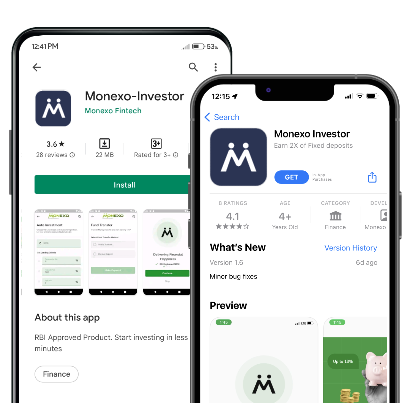Starting your investment journey? Or looking for an addition to your portfolio that provides higher, better returns? Here’s a guide on P2P Lending – an avenue you’d certainly want to consider, What is p2p lending?
Peer-to-peer lending, also abbreviated as P2P lending, is the practice of lending money to individuals or businesses through online services. These services match lenders with borrowers in a decentralised manner. There is no involvement of traditional institutions like banks.
Let’s took a look at how P2P lending works from both borrower and lender perspective
The Borrower Perspective
Seeking loans from banks has typically been a stressful procedure. Selecting your bank from a plethora of options, filling out an application, waiting for documents (and your profile) to be verified, signing multiple papers and finally the long wait after which the loan amount arrives. That too on an interest rate which may deliver a heavy blow to your earnings.
But what if there was an easier, more customer-friendly way? Well, there is.
P2P lending helps borrowers with access to loans from multiple individual/Peer-to-peer lending. Think of it like a marketplace (like Ola or Uber) for loans, where there are multiple lenders available to fund your loans. The best part? It’s simple and 100% online.
- You raise a loan request with the required amount, and the platform will verify your credentials & documents
- Once your loan request is approved, it’ll be made live on the platform.
- Lenders can now see your profile, assess you and lend you money.
- Highly private and secure. No personal details (or documents) are broadcast to all lenders. Instead, lenders see only the information useful in making a judgement on their investments (like interest rate, repayment tenure, past payment history)
- Funding is quicker as there are multiple lenders available to fund the loan
- The loan amount gets credited directly to your bank account and your EMI payments can be made through auto debit of your bank account. The platform will take care of routing it to all the individual lenders
At the end of the day, it’s a marketplace where everyone gets to choose for themselves!
The Lender Perspective
For investors, it is an ideal opportunity to earn high and earn safe. P2P Lending has been gaining rapid adoption amongst lenders across the country, and the reasons aren’t surprising surprise if you think about it. It comes without the volatility of the stock market, and without the low returns of other avenues such as a fixed deposit. It’s also regulated, and offers a sufficient amount of security.
Here’s the lender perspective on P2P Lending:
- The lender has the ability to choose the risk profile of the borrower he wants to lend money to, as the P2P platform provides all the required details like salary, debt service ratio, past repayment records.
- Further, P2P platforms like Monexo have an internal risk grading mechanism, where the loan contracts are risk graded and priced accordingly for the lenders’ benefit.
- The lender has the ability (and should) to diversify his P2P portfolio across multiple loan contracts as he can lend an amount as low as Rs 1000.
- In a platform like Monexo, there is a clear demarcation of lender funds through an escrow account. This ensures that lender funds are only applied to the loan contracts chosen by them and not for any other purpose.
- In case of delayed payments by the borrower, safeguards are provided by the P2P platform by ensuring prompt reporting to credit bureau thus impacting borrower credit score and his ability to avail future credit.
- P2P platform also undertake collection efforts to get back delayed/skipped payment from borrowers including collection calls, physical visits to borrower residence and office, legal recovery actions.
- Overall, for the lender investing in P2P is an attractive proposition. The average returns earned by the investors is in upwards of 15%.
The evolution of P2P lending in India
The indian retail financial system was dominated by only a few banks and NBFCs. In the absence of competition, these institutions had become complacent leading to outdated technology and absence of innovation. These institutions are wired to prioritise protecting their bottom lines over expanding in the market.
On the other hand, P2P Lending platform functions differently. Greater and innovative use of technology have enabled the platforms to use non traditional data (such as social media usage, location history, and more) to verify borrowers profile more accurately. This has led to easier and faster access to credit for genuine borrowers.
The origination of P2P lending in India can be traced back to 2012, which is when the country’s first P2P Lending portals began to emerge.
- The growth that followed was rapid. Within just a few years, the country was brimming with over 30 such P2P intermediaries
- The idea was received with great enthusiasm across the country, as a large section of India’s borrowers and lenders stood to benefit generously from the platforms.
The recent Non-Banking Financial Company – Peer to Peer Lending Platform (Reserve Bank) Directions, 2017 passed by the RBI has provided the industry with much needed regulation and direction.
Some of the salient features of the Master Directions are:
Registration process: Every existing and prospective NBFC-P2P shall make an application for registration to the Department of Non-Banking Regulation, Mumbai. Existing NBFC-P2Ps shall apply within three months from the issuance of these directions
Net owned fund—at least 2 crore: The RBI has regulated that all the registered NBFC-P2P must have a net owned fund of not less than 2 crores. This is necessary for the encouragement of the credibility of the industry. Also, it requires a good amount for the investment in technology, credit assessment and customer support once the platform is set up. this appears to be an appreciable to discourage fraudulent and non-serious players.
Leverage Ratio: RBI has asked these platforms to maintain a leverage ratio not exceeding 2. The leverage ratio is the representation of debt vs owned capital in any organisation. This would be helpful in bringing financial stability to the platform.
Escrow Account: It is necessary for all NBFCs to maintain two escrow accounts through which all the P2P transactions are processed—one for investments and the other for collection from borrowers. This would make the functioning smoother, faster and secured. Monexo deployed an escrow account for its customers far earlier than the regulations, and was already in compliance with this guideline.
Lending and Borrowing Amount: A lender can lend an aggregate amount not exceeding Rs. 10,00,000/- across all P2Ps platforms at any point. similarly; a borrower can borrow not exceeding Rs. 10,00,000/- across all P2P platforms. However, the exposure of a single borrower to the same lender across all P2P platforms shall not exceed Rs.50,000/-.
Submission of data to CICs At last, all P2P NBFCs have been instructed to submit their data to Credit Information Companies(credit bureaus). This would help bring more credibility to the system, and as credibility attracts investments, this would help the industry grow.
The Master Direction passed by the RBI are likely to help P2P lending achieve sustainability in India. A sustainable operational model is bound to help rank P2P lending among prospering investment classes.




